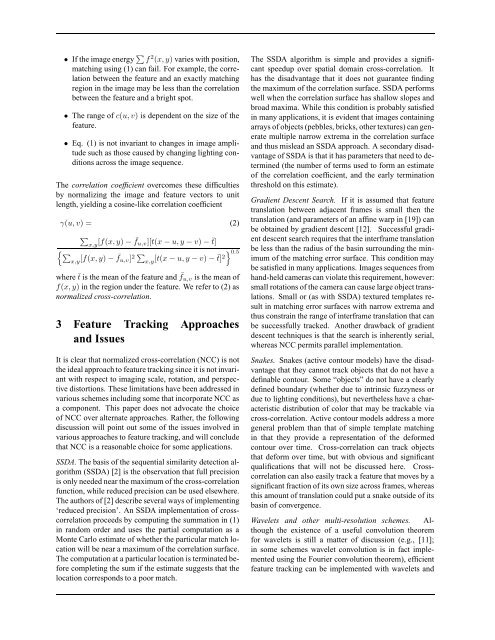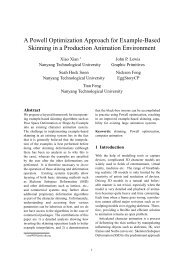Fast Normalized Cross-Correlation - JP Lewis
Fast Normalized Cross-Correlation - JP Lewis
Fast Normalized Cross-Correlation - JP Lewis
You also want an ePaper? Increase the reach of your titles
YUMPU automatically turns print PDFs into web optimized ePapers that Google loves.
• If the image energy � f 2 (x, y) varies with position,<br />
matching using (1) can fail. For example, the correlation<br />
between the feature and an exactly matching<br />
region in the image may be less than the correlation<br />
between the feature and a bright spot.<br />
• The range of c(u, v) is dependent on the size of the<br />
feature.<br />
• Eq. (1) is not invariant to changes in image amplitude<br />
such as those caused by changing lighting conditions<br />
across the image sequence.<br />
The correlation coefficient overcomes these difficulties<br />
by normalizing the image and feature vectors to unit<br />
length, yielding a cosine-like correlation coefficient<br />
γ(u, v) = (2)<br />
�<br />
x,y [f(x, y) − ¯ fu,v][t(x − u, y − v) − ¯t]<br />
�� x,y [f(x, y) − ¯ �<br />
fu,v]<br />
2<br />
x,y [t(x − u, y − v) − ¯t] 2<br />
� 0.5<br />
where ¯t is the mean of the feature and ¯ fu,v is the mean of<br />
f(x, y) in the region under the feature. We refer to (2) as<br />
normalized cross-correlation.<br />
3 Feature Tracking Approaches<br />
and Issues<br />
It is clear that normalized cross-correlation (NCC) is not<br />
the ideal approach to feature tracking since it is not invariant<br />
with respect to imaging scale, rotation, and perspective<br />
distortions. These limitations have been addressed in<br />
various schemes including some that incorporate NCC as<br />
a component. This paper does not advocate the choice<br />
of NCC over alternate approaches. Rather, the following<br />
discussion will point out some of the issues involved in<br />
various approaches to feature tracking, and will conclude<br />
that NCC is a reasonable choice for some applications.<br />
SSDA. The basis of the sequential similarity detection algorithm<br />
(SSDA) [2] is the observation that full precision<br />
is only needed near the maximum of the cross-correlation<br />
function, while reduced precision can be used elsewhere.<br />
The authors of [2] describe several ways of implementing<br />
‘reduced precision’. An SSDA implementation of crosscorrelation<br />
proceeds by computing the summation in (1)<br />
in random order and uses the partial computation as a<br />
Monte Carlo estimate of whether the particular match location<br />
will be near a maximum of the correlation surface.<br />
The computation at a particular location is terminated before<br />
completing the sum if the estimate suggests that the<br />
location corresponds to a poor match.<br />
The SSDA algorithm is simple and provides a significant<br />
speedup over spatial domain cross-correlation. It<br />
has the disadvantage that it does not guarantee finding<br />
the maximum of the correlation surface. SSDA performs<br />
well when the correlation surface has shallow slopes and<br />
broad maxima. While this condition is probably satisfied<br />
in many applications, it is evident that images containing<br />
arrays of objects (pebbles, bricks, other textures) can generate<br />
multiple narrow extrema in the correlation surface<br />
and thus mislead an SSDA approach. A secondary disadvantage<br />
of SSDA is that it has parameters that need to determined<br />
(the number of terms used to form an estimate<br />
of the correlation coefficient, and the early termination<br />
threshold on this estimate).<br />
Gradient Descent Search. If it is assumed that feature<br />
translation between adjacent frames is small then the<br />
translation (and parameters of an affine warp in [19]) can<br />
be obtained by gradient descent [12]. Successful gradient<br />
descent search requires that the interframe translation<br />
be less than the radius of the basin surrounding the minimum<br />
of the matching error surface. This condition may<br />
be satisfied in many applications. Images sequences from<br />
hand-held cameras can violate this requirement, however:<br />
small rotations of the camera can cause large object translations.<br />
Small or (as with SSDA) textured templates result<br />
in matching error surfaces with narrow extrema and<br />
thus constrain the range of interframe translation that can<br />
be successfully tracked. Another drawback of gradient<br />
descent techniques is that the search is inherently serial,<br />
whereas NCC permits parallel implementation.<br />
Snakes. Snakes (active contour models) have the disadvantage<br />
that they cannot track objects that do not have a<br />
definable contour. Some “objects” do not have a clearly<br />
defined boundary (whether due to intrinsic fuzzyness or<br />
due to lighting conditions), but nevertheless have a characteristic<br />
distribution of color that may be trackable via<br />
cross-correlation. Active contour models address a more<br />
general problem than that of simple template matching<br />
in that they provide a representation of the deformed<br />
contour over time. <strong>Cross</strong>-correlation can track objects<br />
that deform over time, but with obvious and significant<br />
qualifications that will not be discussed here. <strong>Cross</strong>correlation<br />
can also easily track a feature that moves by a<br />
significant fraction of its own size across frames, whereas<br />
this amount of translation could put a snake outside of its<br />
basin of convergence.<br />
Wavelets and other multi-resolution schemes. Although<br />
the existence of a useful convolution theorem<br />
for wavelets is still a matter of discussion (e.g., [11];<br />
in some schemes wavelet convolution is in fact implemented<br />
using the Fourier convolution theorem), efficient<br />
feature tracking can be implemented with wavelets and







